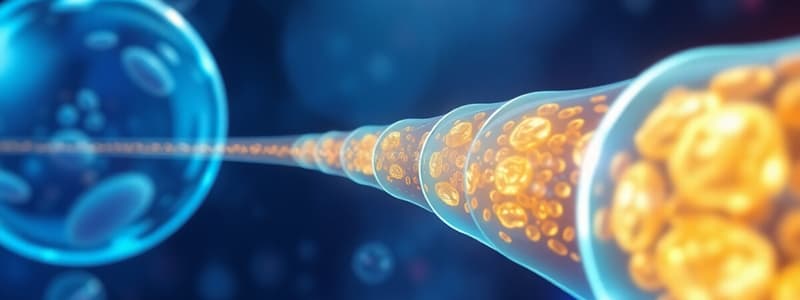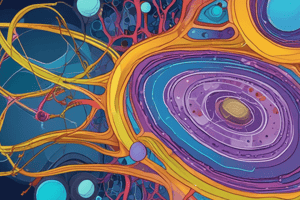Podcast
Questions and Answers
What is the role of the cell membrane in homeostasis?
What is the role of the cell membrane in homeostasis?
- It provides structural support to the cell.
- It regulates the movement of materials in and out of the cell. (correct)
- It allows all substances to pass freely.
- It stores energy for the cell.
Which type of molecules can pass easily through the cell membrane?
Which type of molecules can pass easily through the cell membrane?
- Large polar molecules
- Large hydrophilic molecules
- Charged ions
- Small nonpolar molecules (correct)
What is passive transport characterized by?
What is passive transport characterized by?
- Involvement of vesicles to move substances.
- Movement against the concentration gradient.
- Use of ATP to transport materials.
- Movement with the concentration gradient without energy use. (correct)
What distinguishes active transport from passive transport?
What distinguishes active transport from passive transport?
What does the term 'solute' refer to?
What does the term 'solute' refer to?
Which of the following is an example of active transport?
Which of the following is an example of active transport?
How is the term 'solution' best defined?
How is the term 'solution' best defined?
Which statement about polar molecules and the cell membrane is accurate?
Which statement about polar molecules and the cell membrane is accurate?
What term describes the process where molecules spread across a membrane until equilibrium is reached?
What term describes the process where molecules spread across a membrane until equilibrium is reached?
Which mechanism utilizes transport proteins to aid in the diffusion of certain molecules?
Which mechanism utilizes transport proteins to aid in the diffusion of certain molecules?
Which of the following molecules typically use facilitated diffusion to cross the cell membrane?
Which of the following molecules typically use facilitated diffusion to cross the cell membrane?
Which statement about transport proteins is true?
Which statement about transport proteins is true?
What is the term for the simple diffusion of water across a membrane?
What is the term for the simple diffusion of water across a membrane?
In a hypotonic solution, the concentration of water is ______ compared to the cell cytoplasm.
In a hypotonic solution, the concentration of water is ______ compared to the cell cytoplasm.
What effect does a hypertonic solution have on a cell?
What effect does a hypertonic solution have on a cell?
What happens to a cell in an isotonic solution?
What happens to a cell in an isotonic solution?
What occurs in a hypotonic solution with respect to water movement?
What occurs in a hypotonic solution with respect to water movement?
What happens to the cell in a hypertonic solution?
What happens to the cell in a hypertonic solution?
What term describes the use of energy to move molecules across the membrane?
What term describes the use of energy to move molecules across the membrane?
Which process uses vesicles to move large particles into the cell?
Which process uses vesicles to move large particles into the cell?
What is the function of exocytosis?
What is the function of exocytosis?
Which of the following ions is NOT typically involved in active transport mechanisms?
Which of the following ions is NOT typically involved in active transport mechanisms?
In which type of transport does a cell NOT require energy?
In which type of transport does a cell NOT require energy?
What is primarily concentrated within a cell through active transport?
What is primarily concentrated within a cell through active transport?
Flashcards
Cell membrane permeability
Cell membrane permeability
The cell membrane is selectively permeable, meaning it controls what substances can enter and exit the cell.
Passive Transport
Passive Transport
The movement of molecules from an area of high concentration to an area of low concentration, without requiring the cell to expend energy.
Active Transport
Active Transport
The movement of molecules from an area of low concentration to an area of high concentration, requiring the cell to expend energy.
Solute
Solute
Signup and view all the flashcards
Solvent
Solvent
Signup and view all the flashcards
Solution
Solution
Signup and view all the flashcards
Concentration
Concentration
Signup and view all the flashcards
Osmosis
Osmosis
Signup and view all the flashcards
Simple Diffusion
Simple Diffusion
Signup and view all the flashcards
Facilitated Diffusion
Facilitated Diffusion
Signup and view all the flashcards
Hypertonic Solution
Hypertonic Solution
Signup and view all the flashcards
Hypotonic Solution
Hypotonic Solution
Signup and view all the flashcards
Isotonic Solution
Isotonic Solution
Signup and view all the flashcards
Equilibrium
Equilibrium
Signup and view all the flashcards
Transport Proteins
Transport Proteins
Signup and view all the flashcards
Endocytosis
Endocytosis
Signup and view all the flashcards
Exocytosis
Exocytosis
Signup and view all the flashcards
Study Notes
Cell Transport Schedule
- Wednesday, December 4: Take cell test. Define terms for section 8.3. Turn in notebook for participation grade.
Cell Transport Notes (December 5)
- Notes: Page 21
- Activities: Cell Transport flash cards, 8.3 Assignment
Cell Membrane
- Homeostasis is maintained through regulation at the cellular level, down to the organ level.
- The plasma membrane controls movement of materials in and out of the cell maintaining homeostasis.
Cell Membrane Permeability
- The cell membrane is selectively permeable, being picky about what goes in and out.
- Small, nonpolar, hydrophobic & neutral molecules and water can pass easily.
- Polar and large molecules cannot pass easily.
Cell Transport Types
- Transport of materials into and out of the cell is either passive or active.
Passive Transport
- No energy required.
- Molecules move from high concentration to low concentration (down the concentration gradient).
- Examples: Simple diffusion, facilitated diffusion, osmosis.
Active Transport
- Energy (ATP) required.
- Molecules move against the concentration gradient, from low concentration to high concentration.
- Examples: Molecular pumps, exocytosis, and endocytosis.
Words to Know
- Solute: Substance that dissolves
- Solvent: Substance that does the dissolving
- Solution: Uniform mixture of two or more substances
- Concentration: Amount of solute in a solvent
Quizzes/Assignments
- December 4: Define terms from section 8.3 (graded)
- December 5: 8.3 Assignment, Cell Transport flashcards.
- Multiple Questions (notebook): True/false: Small things can easily move through cell membrane, Polar molecules easily pass through the cell membrane, Does passive transport require energy, True/false Active transport requires extra energy, What term means a uniform mixture?, (stamped)
Passive Transport: Simple Diffusion
- Molecules spread out across a membrane until equilibrium is reached.
- Equilibrium means equal concentration on both sides of the membrane.
- Molecules move down a concentration gradient from high [] to low []
- Examples include O2, CO2, and other small non-polar molecules.
Passive Transport: Facilitated Diffusion
- Transport proteins help facilitate diffusion of molecules that cannot pass through the cell membrane easily.
- Transport proteins can act as channels or carriers.
- Molecules move down the concentration gradient from high [] to low [ ].
- Examples: Large molecules like glucose, and polar molecules like calcium.
Passive Transport: Osmosis
- The simple diffusion of water across the cell membrane.
- Water molecules move from high water concentration to low water concentration.
- Equilibrium is reached when the water concentration is equal across the membrane.
- High water concentration means low solute concentration and vice versa.
Passive Transport: Osmosis (Solutions)
- Hypertonic solutions: Water concentration is lower outside the cell. Water moves out of the cell, causing the cell to shrink (shrivel).
- Hypotonic solutions: Water concentration is higher outside the cell. Water moves into the cell, causing the cell to swell.
- Isotonic solutions: Water concentration is the same inside and outside the cell. No net movement of water, cell stays the same size.
Questions/Activities (for student notebooks) (December 5)
- What term means equally concentrated on both sides of the membrane? (Equilibrium)
- What helps to facilitate the diffusion of molecules that couldn't pass through on their own? (Transport proteins)
- What are two examples of molecules that use facilitated diffusion to cross the cell membrane? (glucose, calcium)
- True or false: Transport proteins act only as carriers. (False)
- What term refers to the simple diffusion of water across the cell membrane? (Osmosis)
- Low water concentration means _____ solute concentration. (High)
Additional Schedule
- December 6: Edpuzzle on cell transport, work on 8.3 reading guide (no class time).
- December 9: Notes on diffusion and osmosis, lab: Effect of temperature on rate of diffusion, review
- December 10: Set up potato lab, finish yesterday's assignments, Osmosis review & interpreting diagrams, Osmosis Practice (get a stamp), write lab report
- December 11: Study flash cards, Brain dump on Canvas, Osmosis problems (get a stamp)
- December 12: Osmosis review, Finish osmosis problems, Finish notes on cell transport, Graphic organizer
- December 13: Graphic organizer (tape it in notebook), set up egg osmosis lab, video clip on animals (3 notes), define words on page 800
- December 16: Egg lab part 2, Finish vocabulary, Graphing practice, Review for final
Active Transport: Molecular Pumps
- A cell uses energy to pump molecules against the [] gradient across a protein channel.
- This allows the cell to concentrate key substances or remove waste quickly
- Examples include potassium (K+), chlorine (Cl-), and sodium (Na+).
Active Transport: Using Vesicles
- Endocytosis: Uses vesicles to move large particles into the cell. Example: White blood cells engulfing bacteria.
- Exocytosis: Uses vesicles to export materials out of the cell. Example: Nerve cells secreting neurotransmitters.
Additional Questions (notebook December 11)
- In hypotonic solutions, does water enter or leave the cell?
- In a hypertonic solution, what happens to the cell?(Get smaller)
- What is it called when a cell uses energy to pump molecules across the membrane? (Active Transport)
- What is it called when a cell uses vesicles to move large particles into the cell? (Endocytosis)
- What is it called when a cell uses vesicles to export materials out of the cell? (Exocytosis)
Studying That Suits You
Use AI to generate personalized quizzes and flashcards to suit your learning preferences.




